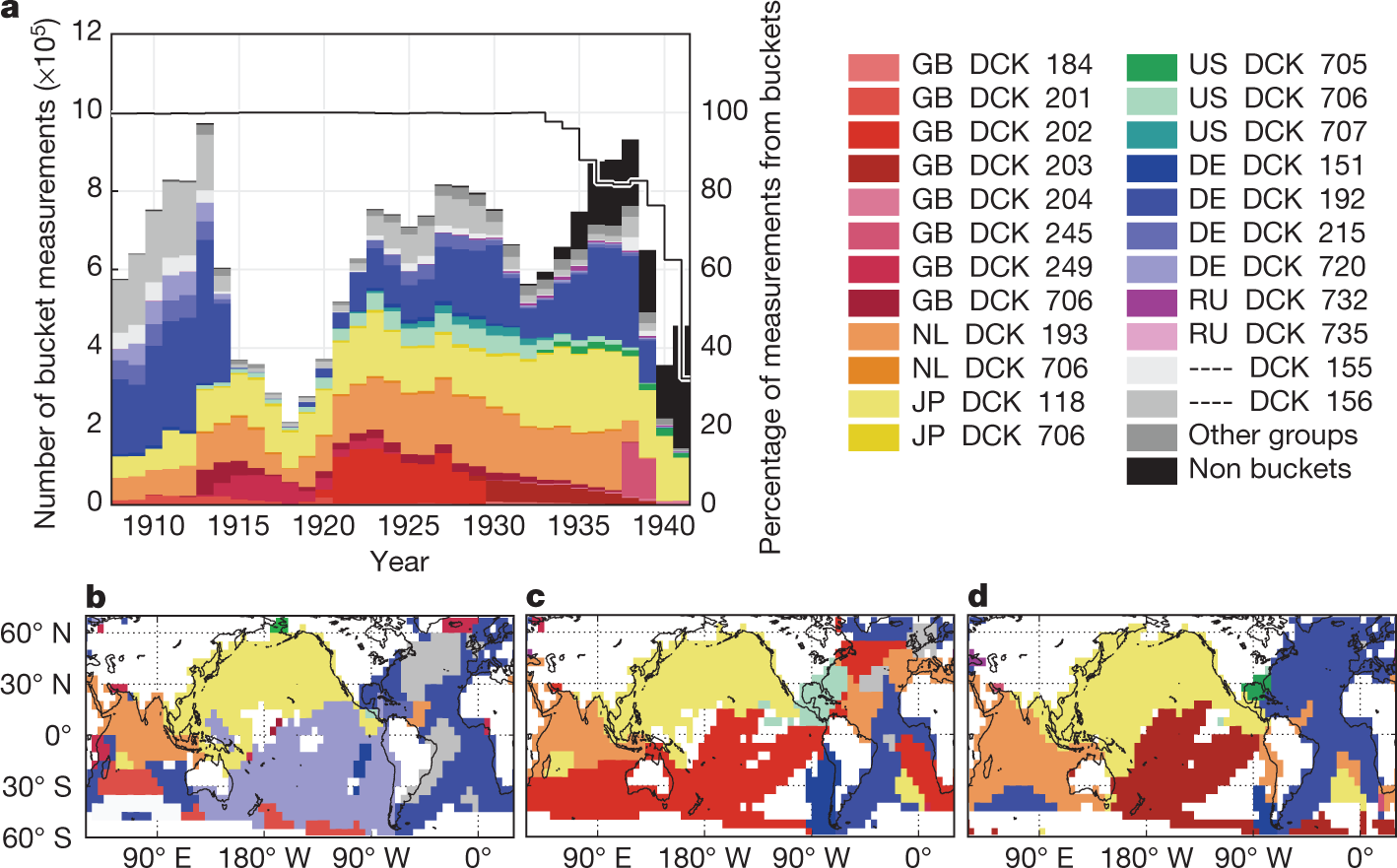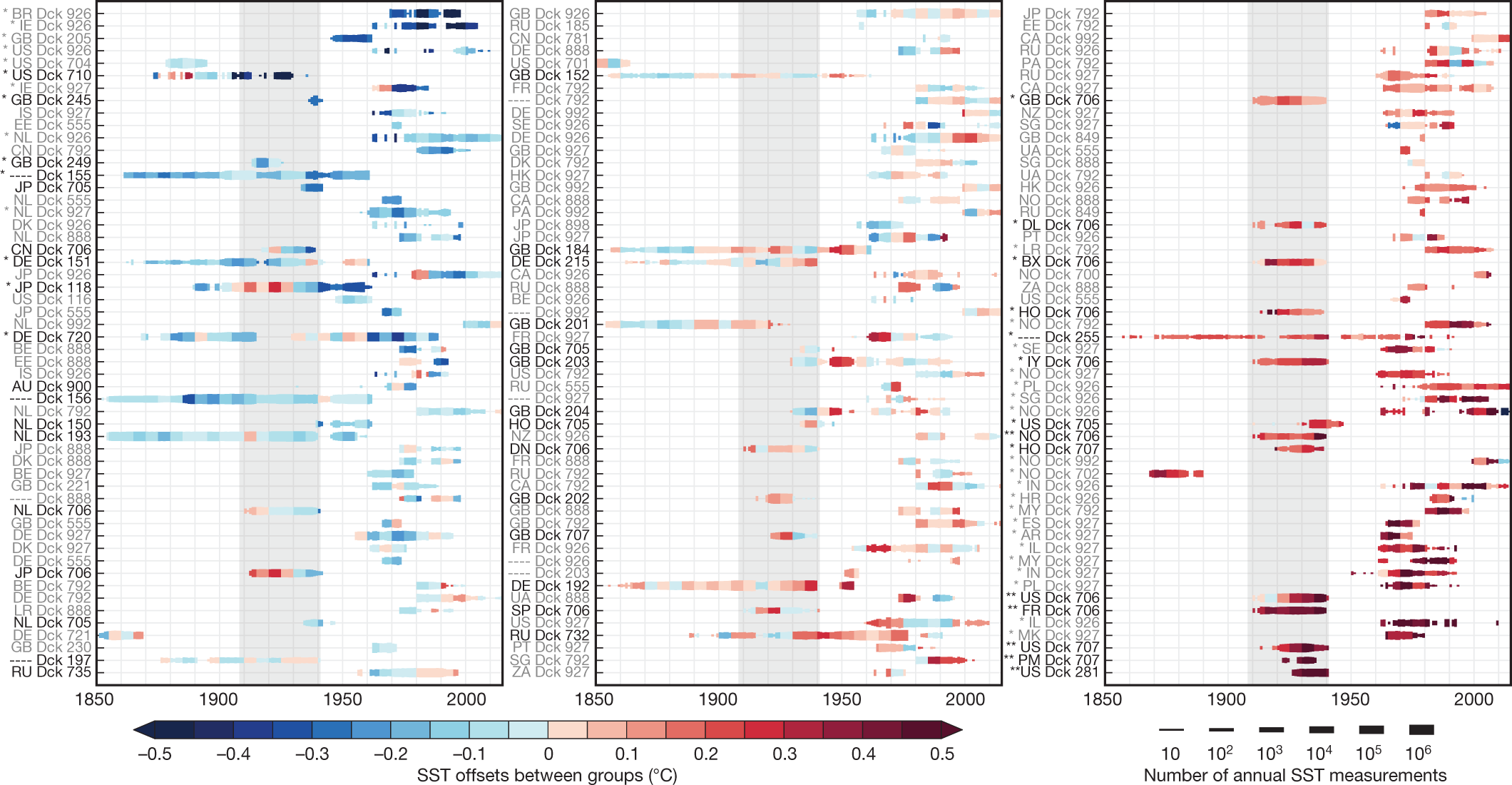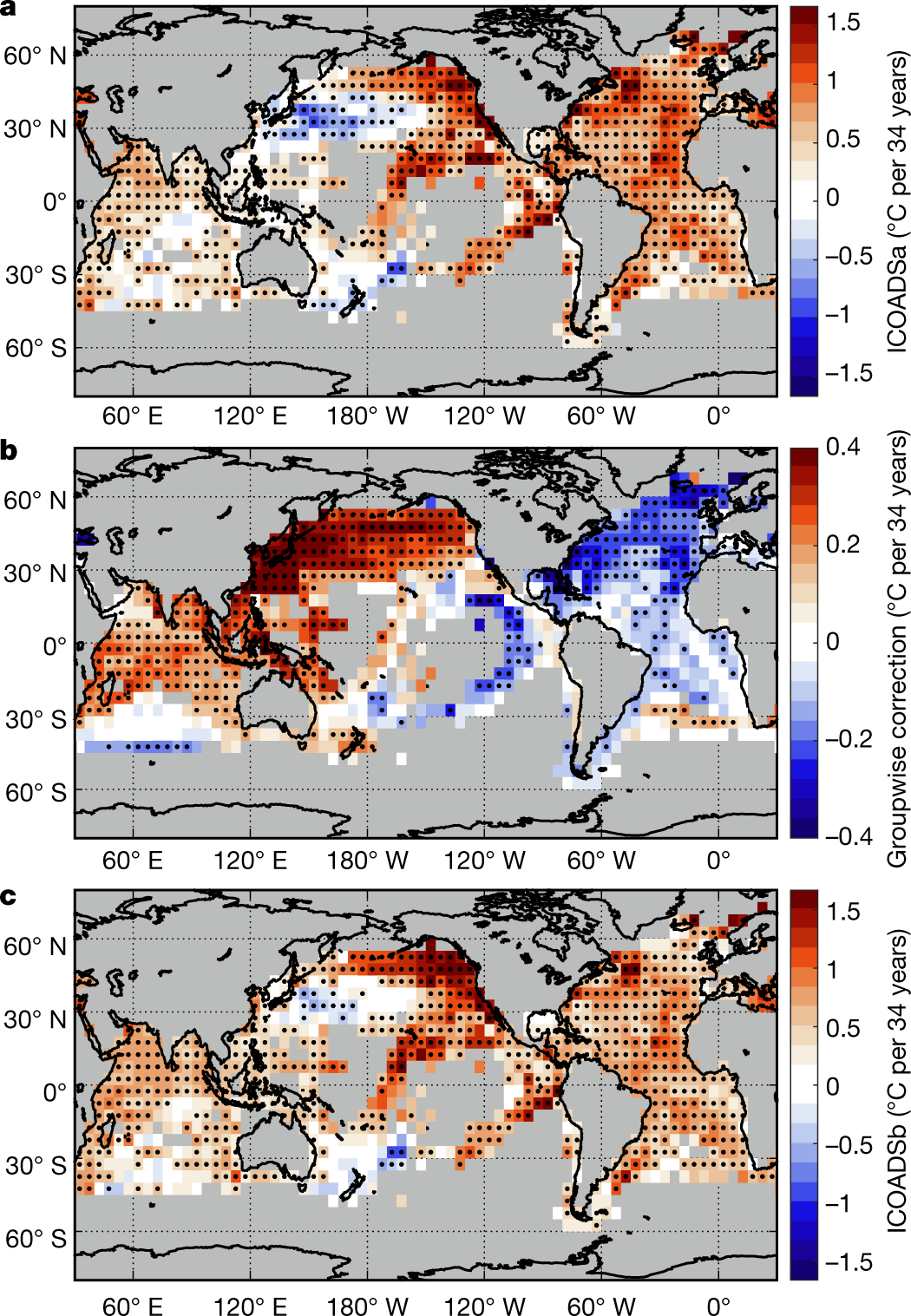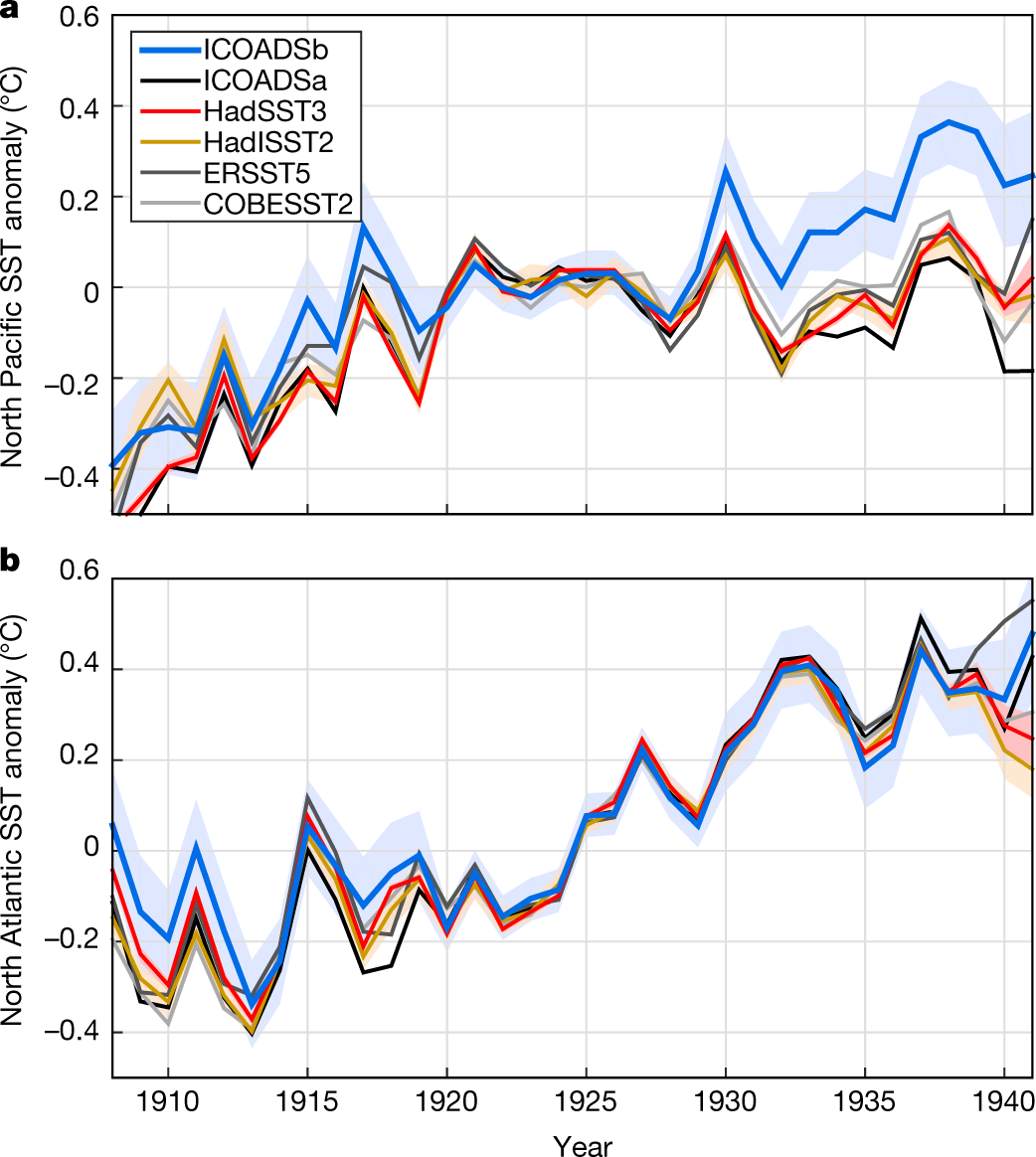Science
Related: About this forumCorrecting datasets leads to more homogeneous early-twentieth-century sea surface warming.
The paper I'll discuss in this post is this one: Correcting datasets leads to more homogeneous early-twentieth-century sea surface warming (Huyber et al Nature 571, 393–397 (2019))
It was really not all that long ago in history that the concept of "temperature" was qualitative as opposed to quantitative; one knew it was, for example, "hot" but how hot in comparison to previous "hot" was not clear. Calibration to international standards has improved greatly in the last 50 years, but the standardization of conditions under which measurements were made varied considerably.
We have chosen to destroy the planetary atmosphere for short term gain, and for those of us who think this may have been a bad, as in immoral, idea, it is important to make temporal comparisons. The problem with doing so is that one cannot really discern how the measurements were made in order to make accurate comparisons.
The paper under discussion is an attempt to adjust for that, to find out if there really are regions of the oceans that are cooling rather than heating. Although it is well known and well understood that the planet as a whole is in a death spiral of heat - Elon Musk's wonderful car for rich people and all the delusional marketing pictures of wind turbines and solar cells notwithstanding - and the that the average overall temperatures are climbing, the situation with respect to certain local areas has not been as clear.
The paper is an effort to address that point by taking a close look at the important issue of accuracy.
From the abstract, which is open sourced:
From the body of the text:
nother possibility is that observational estimates of SST changes contain undetected biases, for which there are some precedents. Difficulty in simulating a slowdown in global warming between 1997 and 2012 was partly reconciled by revising SST estimates19, amongst other considerations20. In another study21, a jump in global temperature by 0.3?°C in 1945 was attributed to offsets between engine-room intake and bucket SST estimates.
The four major SST products covering the early twentieth century each rely upon the International Comprehensive Ocean-Atmosphere Data Set (ICOADS)22, whose latest release is 3.0. It is estimated that 94% of observations between 1908 and 1941 were from buckets (Fig. 1). Bucket measurements of SST are biased by evaporative, sensible and solar heat fluxes that depend on a range of factors, including weather, ship deck height and bucket type7. For example, a canvas bucket left on deck for three minutes under typical wind and other weather conditions can give water temperatures that are approximately 0.5?°C cooler than a wooden bucket measured using the same protocol7,9...
Some graphics from the paper:
 ?
?
The caption:

The caption:

The caption:

The caption:
From the conclusion:
Maybe things are worse than we think, although at 415 ppm CO2 levels having been hit this year, things are clearly pretty bad.
The 2003 European heatwave is said to have killed 70,000 people, upon analysis.
Death toll exceeded 70,000 in Europe during the summer of 2003 (Plus de 70 000 décès en Europe au cours de l'été 2003) (Robine et al Comptes Rendus Biologies
Volume 331, Issue 2, February 2008, Pages 171-178.)
Global warming is an issue involved dangerous fossil fuel waste.
Still, at this point, including 2019, the death toll from heat has yet to rival the death toll from exposure to dangerous fossil fuel combustion wastes and dangerous biomass combustion wastes, aka air pollution, more than 7 million deaths per year.
It's too bad of course, that our knee jerk discussions of energy wastes tends to focus on so called "dangerous nuclear waste" even though the "dangerous" adjective is applied by air heads who cannot point to a death toll on the order of 70,000 deaths over the whole life time of commercial nuclear energy, never mind a single summer, and nothing like the 70,000,000 people who died in the last ten years from dangerous fossil fuel and biomass combustion wastes.
Tell me again, so I can understand it, just how dangerous so called "nuclear waste" is in comparison. )Only numerical historical data can be worthy of respect, wild-assed paranoid speculations don't count.)
We live on an insane planet, and not all of the insanity derives from the ugly orange ignoramus racist in the White House.
Have a nice weekend.
msongs
(67,405 posts)NNadir
(33,516 posts)...in many of the posts originating here with me.
However, I am acquainted with the dangerous and deadly notion that science is too much to "plow through."
It's funny, with all the wonderful retrospectives on the Apollo program how far we've come from times in which scientists and engineers were respected.
I also surely don't expect some person emoting about some bullshit crap about so called "nuclear waste" to appreciate science.
I asked a simple and direct question of anyone who is concerned about the concept of so called "nuclear waste."
Valuable used nuclear fuels have been accumulating for more than 60 years in the commercial sphere. I understand the science of these materials intimately. I challenged someone to produce data that it kills something like the 70 million people who died from air pollution.
Here is the most recent full report from the Global Burden of Disease Report, a survey of all causes of death and disability from environmental and lifestyle risks: Global, regional, and national comparative risk assessment of 79 behavioural, environmental and occupational, and metabolic risks or clusters of risks, 1990–2015: a systematic analysis for the Global Burden of Disease Study 2015 (Lancet 2016; 388: 1659–724) One can easily locate in this open sourced document compiled by an international consortium of medical and scientific professionals how many people die from causes related to air pollution, particulates, ozone, etc.
Where exactly in this publication is the death toll from so called "nuclear waste," or a putative "nuclear waste industry?"
If someone has an answer to this very simple question, it should be fairly easy to produce it. I mean, used nuclear fuel has been accumulating for more than half a century. Where, exactly, are the dead?
If, in contrast to producing real numbers, someone complains about the obvious inference that someone can draw from the results of attack on the nuclear industry - that would be climate change, heat deaths, and air pollution deaths - attacks on an industry which has prevented the dumping of more than 30 billion tons of carbon dioxide, and might have done far more were it not for the ignorant and fearful, easily interpreted from data, well, I'm unimpressed.
Prevented Mortality and Greenhouse Gas Emissions from Historical and Projected Nuclear Power (Pushker A. Kharecha* and James E. Hansen Environ. Sci. Technol., 2013, 47 (9), pp 4889–4895)
I'm used to ignorance, as we live in obvious times where it is celebrated, largely but hardly only on the right.
The fact that anti-nukes hold scientific publications in contempt is hardly news to me. I'm used to that.
Really though, these people just piss me off. Their ignorance is destroying a future that did not belong to them, betting the future on horseshit "by 2050" and "by 2100" bull about so called "renewable energy" that is not sustainable, did not work, is not working, and won't work.
Mostly these days I put these awful people with their Trump type distortions of reality on my ignore list here, but here and there, I forget a few, at least until they show up whining rather than producing real numbers.
Have a nice life.
cstanleytech
(26,291 posts)an ongoing issue for a few hundred years.
Partly due to a natural warming trend of course as we are leaving the last ice age but also partly man made as the industrial revolution started and we started to use fossil fuels in abundance not to mention the waste heat from all our industry has to go somewhere which it seems is ultimately the oceans.